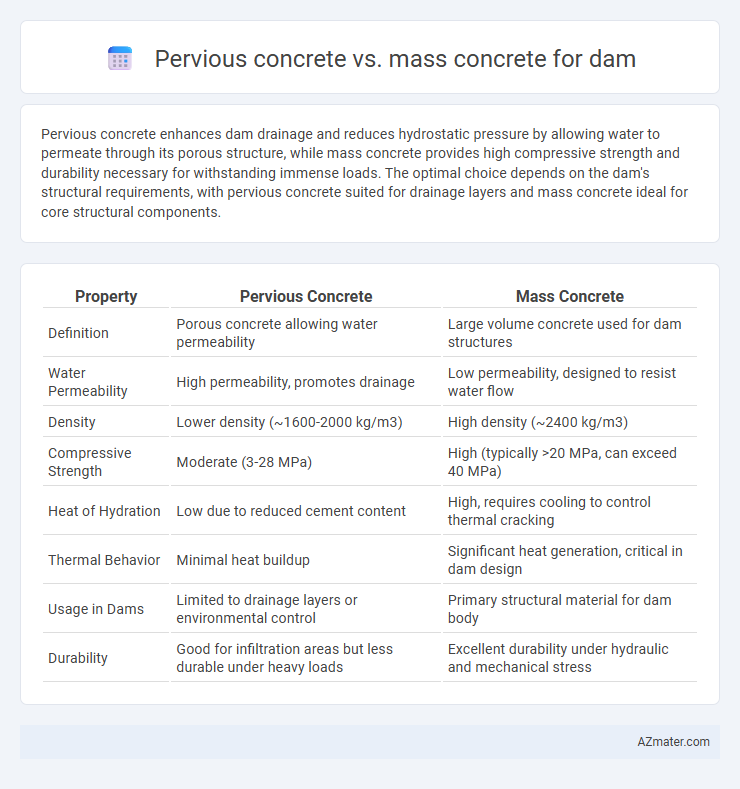Pervious concrete enhances dam drainage and reduces hydrostatic pressure by allowing water to permeate through its porous structure, while mass concrete provides high compressive strength and durability necessary for withstanding immense loads. The optimal choice depends on the dam's structural requirements, with pervious concrete suited for drainage layers and mass concrete ideal for core structural components.
Table of Comparison
| Property | Pervious Concrete | Mass Concrete |
|---|---|---|
| Definition | Porous concrete allowing water permeability | Large volume concrete used for dam structures |
| Water Permeability | High permeability, promotes drainage | Low permeability, designed to resist water flow |
| Density | Lower density (~1600-2000 kg/m3) | High density (~2400 kg/m3) |
| Compressive Strength | Moderate (3-28 MPa) | High (typically >20 MPa, can exceed 40 MPa) |
| Heat of Hydration | Low due to reduced cement content | High, requires cooling to control thermal cracking |
| Thermal Behavior | Minimal heat buildup | Significant heat generation, critical in dam design |
| Usage in Dams | Limited to drainage layers or environmental control | Primary structural material for dam body |
| Durability | Good for infiltration areas but less durable under heavy loads | Excellent durability under hydraulic and mechanical stress |
Introduction to Concrete Types in Dam Construction
Pervious concrete and mass concrete serve distinct roles in dam construction, each optimized for specific structural and hydraulic functions. Pervious concrete features high porosity, allowing water to pass through, enhancing drainage and reducing hydrostatic pressure behind dam walls. Mass concrete, characterized by its large volume and low permeability, provides the necessary strength and stability to withstand immense loads and environmental stresses in dam structures.
Defining Pervious Concrete and Its Properties
Pervious concrete is a highly porous material designed to allow water to pass through, reducing runoff and promoting groundwater recharge, with a typical porosity ranging from 15% to 25%. Its properties include high permeability, light weight, and excellent drainage capabilities, making it suitable for environmental applications where water control is critical. In contrast, mass concrete is dense and low-permeability, primarily used for structural strength in dam construction, focusing on durability and load-bearing capacity rather than water permeability.
Overview of Mass Concrete and Its Characteristics
Mass concrete used in dam construction is characterized by its large volume and minimal reinforcement, designed to withstand immense structural loads and thermal stresses during curing. Its dense composition offers high compressive strength and durability, essential for ensuring stability and longevity in massive dam structures. Thermal control measures are critical in mass concrete to prevent cracking due to heat generated during cement hydration.
Key Differences: Pervious vs. Mass Concrete
Pervious concrete for dams features high porosity, enabling water infiltration and reducing hydrostatic pressure, whereas mass concrete is dense and designed to withstand immense structural loads and thermal stresses. Pervious concrete's permeability aids in drainage and prevents seepage, while mass concrete provides stability and durability with low permeability to ensure long-term strength. The key difference lies in pervious concrete's emphasis on permeability and infiltration versus mass concrete's focus on compressive strength and thermal control in dam construction.
Structural Performance in Dam Applications
Pervious concrete offers enhanced drainage and reduced hydrostatic pressure in dam structures, improving stability by allowing water to pass through the concrete matrix, which minimizes pore pressure buildup. Mass concrete, characterized by its high density and low permeability, provides superior compressive strength and durability under massive loads but requires meticulous thermal control to prevent cracking due to temperature gradients during curing. Optimizing structural performance in dam applications depends on balancing permeability and strength, where pervious concrete benefits seepage control while mass concrete ensures structural integrity under gravitational and hydraulic stresses.
Durability and Longevity Factors
Pervious concrete enhances dam durability by allowing efficient water drainage, reducing hydrostatic pressure and preventing freeze-thaw damage, which extends structural lifespan. Mass concrete offers exceptional compressive strength and thermal stability, essential for withstanding massive loads and minimizing thermal cracking in dam constructions. Choosing between pervious and mass concrete depends on balancing permeability needs with structural strength to optimize long-term dam performance.
Environmental Impact: Pervious vs. Mass Concrete
Pervious concrete significantly reduces stormwater runoff by allowing water to infiltrate through its porous structure, mitigating flood risks and enhancing groundwater recharge near dam sites. In contrast, mass concrete often leads to increased surface runoff and potential erosion due to its dense, impermeable nature. The eco-friendly characteristics of pervious concrete contribute to sustainable dam construction by promoting natural hydrological cycles and reducing environmental degradation.
Cost Analysis in Dam Construction
Pervious concrete offers cost advantages in dam construction by reducing the need for extensive drainage systems and lowering water management expenses due to its high permeability. Mass concrete, although typically less expensive per cubic meter, incurs higher long-term costs from increased risk of thermal cracking and the need for cooling measures during curing. Evaluating total project costs favors pervious concrete when factoring in durability, maintenance, and environmental compliance in dam engineering.
Case Studies: Dams Utilizing Pervious or Mass Concrete
Case studies of dams utilizing pervious concrete highlight improved drainage and reduced uplift pressure, as seen in the Hoover Dam's drainage galleries where pervious concrete enhances seepage control. Mass concrete applications dominate in structures like the Grand Coulee Dam, with emphasis on thermal control to prevent cracking due to heat of hydration. Comparative analysis reveals pervious concrete's advantage in seepage management, while mass concrete remains critical for structural stability in large-scale dam construction.
Choosing the Right Concrete for Dam Projects
Pervious concrete offers enhanced drainage and reduced hydrostatic pressure, making it ideal for dam projects requiring efficient water flow management and seepage control. Mass concrete provides high compressive strength and thermal stability, essential for large-scale dam structures subjected to significant load and temperature variations. Selecting the appropriate concrete depends on the dam's design specifications, environmental conditions, and performance requirements, ensuring structural integrity and long-term durability.

Infographic: Pervious concrete vs Mass concrete for Dam
 azmater.com
azmater.com